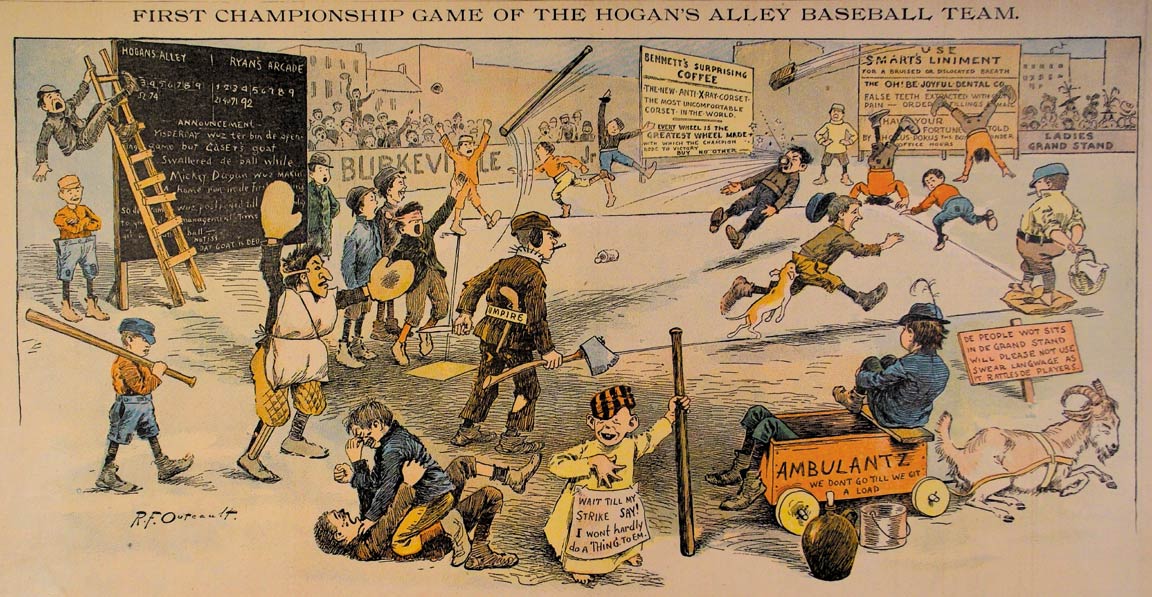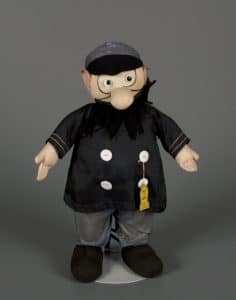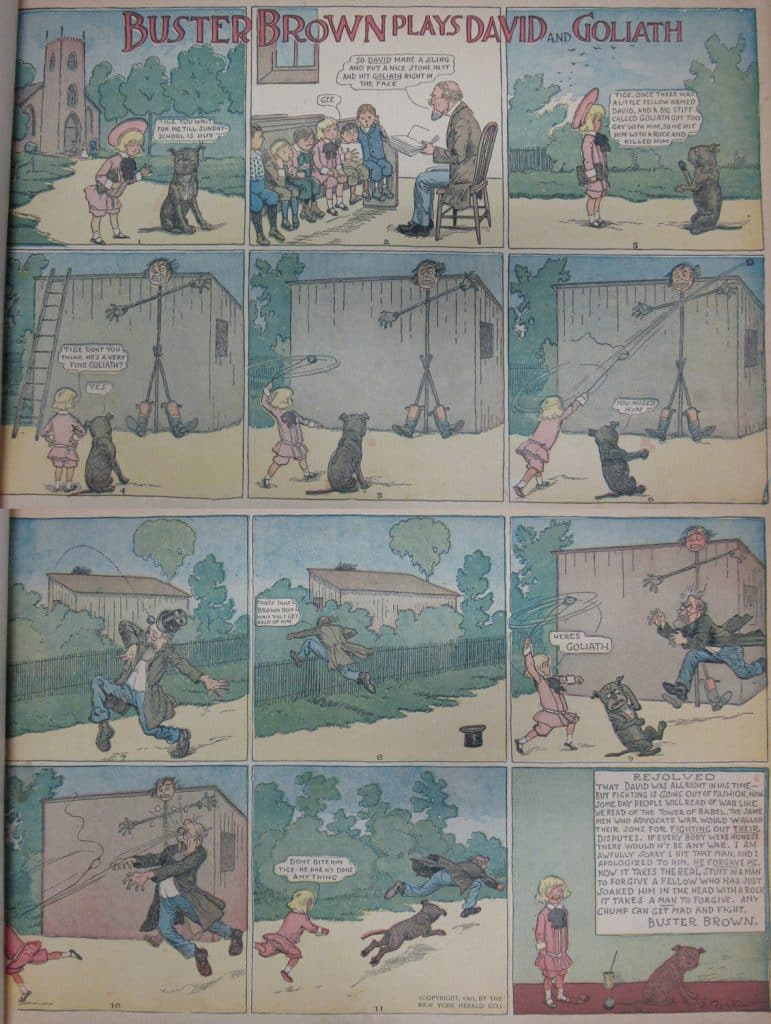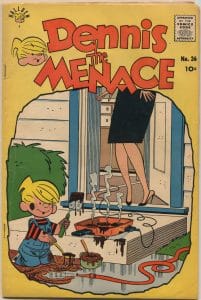I met some naughty kids when I worked as a babysitter and camp counselor. But after five years with the National Museum of Play at The Strong, I’ve observed enough children to know the good ones far outnumber the brats and that misbehavior, when it occurs, isn’t limited to one gender. So why do little boys get a bad rap? Look at the way cartoonists have portrayed them over the years. If I may paraphrase a line from Jessica Rabbit: the kids aren’t bad—they’re just drawn that way.

For example, take the Yellow Kid, a landmark cartoon character who evolved from Richard F. Outcault’s sketches of New York City’s tenement children in the early 1890s. Outcault depicted the bald pipsqueak with jug-handle ears and a dirty, oversized hand-me-down nightshirt in his Hogan’s Alley cartoons for the New York World and Journal. His riotous, violent images of ragamuffins left to their own devices deviated from the standard cartoon art of the time. And the Yellow Kid was their poster child—literally. The emblems printed on his nightgown offered humorous or political commentary. Often the Kid was the only character to make eye contact with the reader—not only to draw attention to those statements, but also to defy adults to control the children’s chaos.
 While the rascals of Hogan’s Alley disregarded most grownups within their world, the Katzenjammer Kids encountered actual adult enforcers in the characters of Mama, Der Captain, and Der Inspector, the truant officer. Rudolph Dirks created the twin delinquents, Hans and Fritz, in 1897 for the New York Journal’s Sunday comics. Whether the boys’ pranks worked like a charm, backfired, or turned out worse than expected, punishment was a near certainty, and it tended to be worse than the crime, provoking the little imps to retaliate. Dirks’s son, John, told Time magazine the adults were more to blame than Hans or Fritz.
While the rascals of Hogan’s Alley disregarded most grownups within their world, the Katzenjammer Kids encountered actual adult enforcers in the characters of Mama, Der Captain, and Der Inspector, the truant officer. Rudolph Dirks created the twin delinquents, Hans and Fritz, in 1897 for the New York Journal’s Sunday comics. Whether the boys’ pranks worked like a charm, backfired, or turned out worse than expected, punishment was a near certainty, and it tended to be worse than the crime, provoking the little imps to retaliate. Dirks’s son, John, told Time magazine the adults were more to blame than Hans or Fritz.
 Buster Brown, on the other hand, took responsibility for his actions… sometimes. Buster’s blond pageboy haircut and Victorian short pants gave him the look of a genteel little fellow. But based on the number of spankings he received over the years, he was just as naughty as the Hogan’s Alley street urchins or Dirks’s little devils. Originating in the New York Herald in 1902, Outcault’s Buster was playful, inquisitive, and mischievous. He spiked his parents’ hair tonic with glue and replaced his father’s golf ball with a bomb. But at the end of each comic strip, Buster penned a lesson learned from the consequences of his behavior. Sometimes he demonstrated genuine contrition, while at other times the statements were evasive at best—perhaps he was just going through the motions because he thought his punishers had been unreasonable. (Likewise, has Bart Simpson ever looked repentant when he’s scratching away at Mrs. Krabappel’s chalkboard?) In “Buster Brown Plays David and Goliath,” from the collections of The Strong, the little-guy-versus-giant theme could serve as a metaphor for the way children come up against adults in many comics. Well-meaning kids unwittingly (or perhaps knowingly, but rarely maliciously) draw the ire of their elders and suffer the consequences.
Buster Brown, on the other hand, took responsibility for his actions… sometimes. Buster’s blond pageboy haircut and Victorian short pants gave him the look of a genteel little fellow. But based on the number of spankings he received over the years, he was just as naughty as the Hogan’s Alley street urchins or Dirks’s little devils. Originating in the New York Herald in 1902, Outcault’s Buster was playful, inquisitive, and mischievous. He spiked his parents’ hair tonic with glue and replaced his father’s golf ball with a bomb. But at the end of each comic strip, Buster penned a lesson learned from the consequences of his behavior. Sometimes he demonstrated genuine contrition, while at other times the statements were evasive at best—perhaps he was just going through the motions because he thought his punishers had been unreasonable. (Likewise, has Bart Simpson ever looked repentant when he’s scratching away at Mrs. Krabappel’s chalkboard?) In “Buster Brown Plays David and Goliath,” from the collections of The Strong, the little-guy-versus-giant theme could serve as a metaphor for the way children come up against adults in many comics. Well-meaning kids unwittingly (or perhaps knowingly, but rarely maliciously) draw the ire of their elders and suffer the consequences.
 Dennis the Menace’s relationship with George Wilson may be the most enduring example of this dynamic. Since his debut in 1951 by Hank Ketcham, Dennis Mitchell has shared everything with his beloved Mr. Wilson: ideas and experiments, captured animals, and of course companionship. Unfortunately something goes wrong whenever Dennis is around, and it affects his curmudgeonly neighbor’s ability to live in peace. One need only see the symbolism in Dennis’s cowlick to know he can’t help it. Despite his sweet disposition, the boy has a wild streak that won’t be tamed.
Dennis the Menace’s relationship with George Wilson may be the most enduring example of this dynamic. Since his debut in 1951 by Hank Ketcham, Dennis Mitchell has shared everything with his beloved Mr. Wilson: ideas and experiments, captured animals, and of course companionship. Unfortunately something goes wrong whenever Dennis is around, and it affects his curmudgeonly neighbor’s ability to live in peace. One need only see the symbolism in Dennis’s cowlick to know he can’t help it. Despite his sweet disposition, the boy has a wild streak that won’t be tamed.
The boys in these comics seek outlets for their energy with consequences they couldn’t have predicted, but that doesn’t make them wicked. They just don’t see eye to eye with the grownups who ultimately discipline them. Fortunately, the cartoonists sympathize as much with the children as with their adult oppressors, so their comics lean more toward humor than horror.



